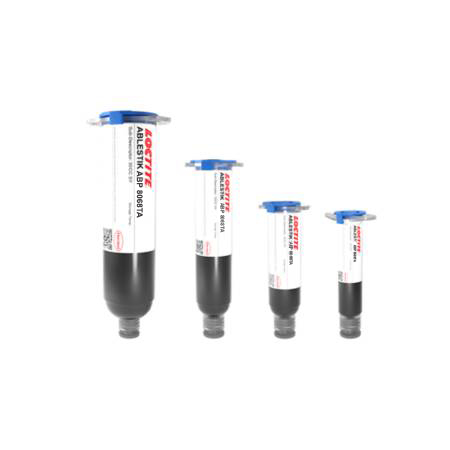LOCTITE ABLESTIK ABP 8068TA
- Excellent workability
- Dispensable
- Printable
Product Description
LOCTITE ABLESTIK ABP 8068TA is a semi-sintering die attach adhesive designed for semiconductor packages requiring high thermal and electrical conductivity. This material’s epoxy assisted sintering formulation is designed to provide high adhesion, high thermal and low stress properties which are essential for thermal and reliability performances of high end power packages. .
LOCTITE ABLESTIK ABP 8068TA has a thermal performance that is comparable to a solder paste material. In conventional box oven curing, it will cure at 1 hour at 200ºC or 175ºC. This silver filled conductive adhesive is printable and dispensable with excellent workability. It offers good sintering properties when used on Ag, PPF, Au and Cu substrates with a high thermal stability. Its high reliability make it a good solder replacement candidate and is typically used for packages such as QFN, LGA and HBLED.
Technical Specifications
| General Properties | |
| Work life @25°C Work life @25°C Work life is the amount of time we have to work with a material until it is no longer able to be easily worked and applied on a substrate. It is based on the change in viscosity and it can rely on the application requirements. | 24 hours |
| Thermal Properties | |
| Thermal Conductivity Thermal Conductivity Thermal conductivity describes the ability of a material to conduct heat. It is required by power packages in order to dissipate heat and maintain stable electrical performance. Thermal conductivity units are [W/(m K)] in the SI system and [Btu/(hr ft °F)] in the Imperial system. | 110 W/m.K |
| Chemical Properties | |
| Moisture absorption | 0.26 % |
| Physical Properties | |
| Thixotropic index Thixotropic index Thixotropic Index is a ratio of a material s viscosity at two different speeds in Ambient temperature, generally different by a factor of ten. A thixotropic material s viscosity will decrease as agitation or pressure is increased. It indicates the capability of a material to hold its shape. Mayonnaise is a great example of this. It holds its shape very well, but when a shear stress is applied, the material easily spreads. It helps in choosing a material in accordance to the application, dispense method and viscosity of a material. | 6 |
| Viscosity Viscosity Viscosity is a measurement of a fluid’s resistance to flow. Viscosity is commonly measured in centiPoise (cP). One cP is defined as the viscosity of water and all other viscosities are derived from this base. MPa is another common unit with a 1:1 conversion to cP. A product like honey would have a much higher viscosity -around 10,000 cPs- compared to water. As a result, honey would flow much slower out of a tipped glass than water would. The viscosity of a material can be decreased with an increase in temperature in order to better suit an application | 9,000 mPa.s |
Additional Information
How would this perform for GaN on SiC to Au plated Cu?
Silicon Nitride is an alternative to Silicon. The wafer / chip is normally fabricated from Silicon Nitride. This is mechanically fairly similar to silicon (it’s a bit harder & more brittle), so die attach that works with silicon is typically good on SiN.
GaN (Gallium Nitride) is a semiconductor layer that is grown on top of a silicon or SiN wafer / chip surface. So for die attach it is similar to attaching a Si or SiN chip.
8068TA is a “semi-sinter” material. It needs a layer of Ag or Au on both the chip & the substrate to give a good bond. An SiC wafer should have a metal back side metallization (BSM) like Ag or Au and this is the surface to sinter to. Bare Cu can also be OK for some “non-critical” applications, but it is not recommended.
Cure Schedule
For die size <5 x 5 mm
- 20 minutes ramp from 25°C to 130°C, hold for 30 to 60 minutes; 15 minutes ramp to 200°C, hold for 60 minutes in N2 or air oven
For die size >5 x 5 mm
- 20 minutes ramp from 25°C to 130°C, hold for 120 minutes; 15 minutes ramp to 200°C, hold for 60 minutes in N2 or air oven
Alternate Cure Schedule
Suitable for Ag, Au and PPF substrates
- 20 minutes ramp from 25°C to 130°C, hold for 30 minutes; 10 minutes ramp to 175°C, hold for 60 minutes in N2 or air oven



